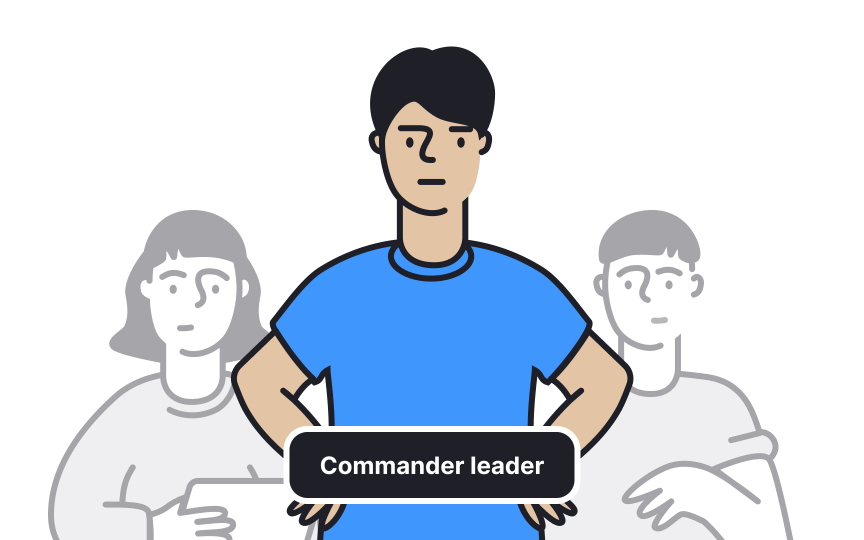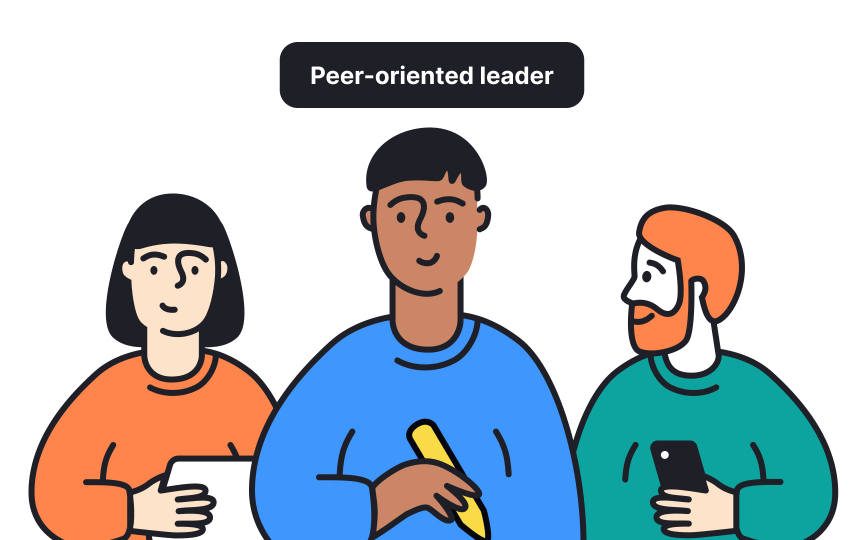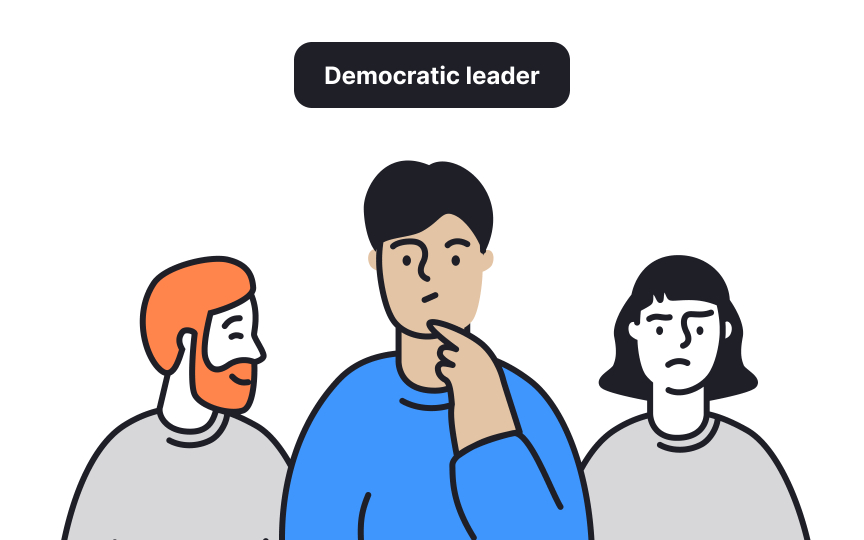Leadership Styles
Explore different leadership styles and combine traits from various approaches to create your unique way of guiding your team effectively
Leading a design team is like mixing colors on a palette — you blend different styles to guide your team best. Our guide on leadership types shows there's no one-size-fits-all approach. You'll likely mix traits from various styles to create your unique way of leading. This mix changes as you gain experience and as your team's needs evolve.
The key to great leadership is finding a method that works well for your team, helping them grow and succeed. Think of yourself as a learner and adapter, ready to adjust your style to bring out the best in your team. Embrace this journey of discovery and growth, shaping a leadership style that's uniquely yours, fostering a creative and supportive team environment.
The commander leadership style is defined by its transactional or autocratic nature, characterized by a strict, results-oriented approach. Commanders are known for setting clear goals and directly addressing both successes and failures to align with business objectives. They motivate their teams through explicit incentives and penalties, fostering rule compliance and standardization.
This leadership style shines in crisis situations where quick, accurate decisions are critical, making it particularly effective in sectors like finance and healthcare, where safety and efficiency are paramount.
However, the commander approach has its downsides:
- They often say "no" to maintain focus, which can distance them from their team
- Their emphasis on obedience may curb genuine engagement and limit creativity
- This can pose challenges in environments that thrive on innovation[1]
Passionate leaders, also known as design evangelists, are a dynamic force in the design world. Their strengths include:
- Deep knowledge and strong opinions about design
- The ability to motivate and move the industry forward, sparking change where design is overlooked
- A skill for convincing even the most doubtful of the importance of design
However, too much passion can become a problem. When zeal becomes too intense, it can push away others, adopting aggressive approaches that leave no room for different opinions. This can be particularly tough for experienced designers, whose valuable insights might be ignored by the evangelist's strong personality.
Passionate leaders should moderate their enthusiasm with a willingness to listen and consider feedback, making sure their passion supports rather than overpowers.
Strategic leaders, or visionaries, excel at seeing the big picture.
They're skilled in:
- Finding paths from problem to solution
- Engaging teams to explore future steps
- Encouraging contributions without relinquishing control
- Setting clear objectives and standards
- Providing clarity and structure to foster innovation within boundaries.
However, visionaries can face challenges. When their big plans become too detached from what's practical or relevant, it can lead to too much creativity that might confuse and disappoint their teams. If visionaries get too caught up in their ideas, they might struggle to give clear, practical advice to their teams. The key for strategic leaders is to balance their broad visions with the real needs and limits of their projects and teams.
Peer-oriented leaders, or "design buddies," step into leadership roles with extensive resumes but little actual leadership experience. They resonate with the day-to-day experiences of staff designers, often acting more like colleagues than bosses.
Their main strengths lie in:
- Advocating for their teams
- Putting people first
- Granting a high level of freedom to individual designers
This approach creates a safe environment for sharing ideas, enhancing collaboration, and boosting motivation through positive team dynamics.
However, their focus on being a friend can lead to challenges:
- Overlooking broader organizational needs
- Struggling to address poor performance or resolve conflicts
- Missing opportunities for constructive criticism, crucial for growth
- Their friendly approach might sometimes be seen as a lack of authority
- Potential for disrespect and weakened team spirit
Peer-oriented leaders navigate a fine line between fostering a collaborative atmosphere and maintaining the discipline and direction necessary for effective leadership.
Democratic leaders blend democratic and charismatic styles, making sure everyone gets to share their opinion. This makes team members feel important, and decisions are more likely to be supported since they reflect the team's ideas.
They stand out by:
- Building strong emotional connections
- Promoting teamwork
- Excelling during tough times
- Being empathetic and understanding
However, striving for everyone to agree can slow things down, making even simple choices take too long. This might also cover up a leader's uncertainty, affecting productivity. Their reluctance to face disagreements and constant aim for harmony can cause problems. Avoiding hard choices might lead to unresolved issues and unclear guidance. They must strike a balance between being kind and making tough decisions for effective leadership.
Dynamos act like coaches, focusing on their team's growth by understanding each member's goals to enhance their performance. They build tight-knit teams through strong individual relationships, encouraging creative problem-solving and a growth mindset.
Challenges include:
- Time management issues due to deep personal connections with each designer
- Difficulty fitting this style into traditional top-down management structures
- The effort to tailor leadership to each designer's needs can be time-consuming
Dynamos excel in fostering continuous learning and self-awareness among leaders. By identifying and addressing their weaknesses, they improve team dynamics and open up growth opportunities. This approach also prepares junior members for future leadership roles, equipping them with essential skills and insights.
The autonomous leader, trusts their creative team deeply, giving them the freedom to deliver exceptional customer experiences and results. They offer guidance only when asked, allowing the team to work independently and encouraging personal working styles and exploration. This leadership style fosters a relaxed and empowering environment, making team members feel confident and valued.
This freedom comes with trade-offs:
- Accountability can become an issue, as team members might try to shift responsibility back to the leader or others, especially if objectives are misunderstood
- The autonomous leader's hands-off approach may be perceived as disinterest, potentially harming team morale, particularly affecting junior designers who seek recognition for their efforts
Autonomous leaders are most effective in highly skilled design teams where senior designers can manage their processes and mentor juniors. This style suits teams serving clients with advanced UX understanding, creating a relaxed culture free from micromanagement. Designers feel liberated to enjoy their work and communicate openly, fostering a productive and positive workplace.
Perfectionist leaders, or "pixel heroes," climb the ladder with their exceptional technical skills and an eye for detail. Their work is outstanding, and as leaders, they strive to elevate their teams to match their level of excellence. Their dedication to quality earns them admiration from their team and respect across the board. However, technical brilliance doesn't guarantee effective leadership.
Pixel heroes' quest for perfection can overshadow their team's broader needs, leading to challenges:
- Overemphasis on perfection can cause them to overlook team needs
- Falling short of high standards may trigger micromanaging
- This approach damages trust, instilling fear of failure over the pursuit of excellence
- The result is often low morale and burnout
Pixel heroes can evolve into great leaders by adopting empathetic management, focusing on their team's growth to encourage striving for excellence without the fear of failure.
References
- A Designers Guide to Design Leadership | ZEUX Innovation | Top UI UX Design Companies in India | UI UX Design Consulting Firms
Top contributors
Topics
From Course
Share
Similar lessons

Who is a Design Leader?

Implementation of Changes in Service Design






























